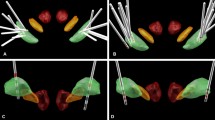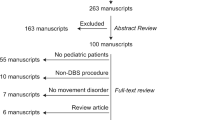Abstract
In many patients, optimal results after pallidal deep brain stimulation (DBS) for primary dystonia may appear over several months, possibly beyond 1 year after implant. In order to elucidate the factors predicting such protracted clinical effect, we retrospectively reviewed the clinical records of 44 patients with primary dystonia and bilateral pallidal DBS implants. Patients with fixed skeletal deformities, as well as those with a history of prior ablative procedures, were excluded. The Burke-Fahn-Marsden Dystonia Rating Scale (BFMDRS) scores at baseline, 1 and 3 years after DBS were used to evaluate clinical outcome. All subjects showed a significant improvement after DBS implants (mean BFMDRS improvement of 74.9% at 1 year and 82.6% at 3 years). Disease duration (DD, median 15 years, range 2–42) and age at surgery (AS, median 31 years, range 10–59) showed a significant negative correlation with DBS outcome at 1 and 3 years. A partition analysis, using DD and AS, clustered subjects into three groups: (1) younger subjects with shorter DD (n = 19, AS < 27, DD ≤ 17); (2) older subjects with shorter DD (n = 8, DD ≤ 17, AS ≥ 27); (3) older subjects with longer DD (n = 17, DD > 17, AS ≥ 27). Younger patients with short DD benefitted more and faster than older patients, who however continued to improve 10% on average 1 year after DBS implants. Our data suggest that subjects with short DD may expect to achieve a better general outcome than those with longer DD and that AS may influence the time necessary to achieve maximal clinical response.

Similar content being viewed by others
Abbreviations
- DBS:
-
Deep brain stimulation
- GPi:
-
Globus pallidus internus
- BFMDRS:
-
Burke-Fahn-Marsden Dystonia Rating Scale
- AS:
-
Age at surgery (in years)
- DD:
-
Disease duration (in years)
- SS:
-
Speech and swallowing
- SY:
-
Subjects with disease duration ≤17 years and age at surgery <27 years
- SO:
-
Subjects with disease duration ≤17 years and age at surgery ≥27 years
- LO:
-
Subjects with disease duration >17 years and age at surgery ≥27 years
References
Geyer HL, Bressman SB (2006) The diagnosis of dystonia. Lancet Neurol 5:780–790
Tarsy D, Simon DK (2006) Dystonia. N Engl J Med 355:818–829
Vidailhet M, Vercueil L, Houeto JL, Krystkowiak P, Benabid AL, Cornu P et al (2005) Bilateral deep-brain stimulation of the Globus Pallidus in primary generalized dystonia. N Engl J Med 352:459–467
Kupsch A, Benecke R, Müller J, Trottenberg T, Schneider GH, Poewe W et al (2006) Pallidal deep-brain stimulation in primary generalized or segmental dystonia. N Engl J Med 355:1978–1990
Vidailhet M, Vercueil L, Houeto JL, Krystkowiak P, Lagrange C, Yelnik J et al (2007) Bilateral, pallidal, deep brain stimulation in primary generalized dystonia: a prospective 3 year follow-up study. Lancet Neurol 6:223–229
Isaias IU, Alterman R, Tagliati M (2009) Deep brain stimulation for primary dystonia: long-term outcomes. Arch Neurol 66:465–470
Alterman RL, Miravite J, Weiss D, Shils JL, Bressman SB, Tagliati M (2007) Sixty hertz pallidal deep brain stimulation for primary torsion dystonia. Neurology 69:681–688
Isaias IU, Alterman RL, Tagliati M (2008) Outcome predictors of pallidal stimulation in patients with primary dystonia: the role of disease duration. Brain 131:1895–1902
Burke RE, Fahn S, Marsden CD, Bressman SB, Moskowitz C, Friedman J (1985) Validity and reliability of a rating scale for the primary torsion dystonia. Neurology 35:73–77
Shils J, Tagliati M, Alterman R (2002) Neurophysiological monitoring during neurosurgery for movement disorders. In: Deletis V, Shils J (eds) Neurophysiology in neurosurgery. Academic Press, San Diego, pp 393–436
Krauss JK, Yianni J, Loher JT, Aziz TZ (2004) Deep brain stimulation for dystonia. J Clin Neurophysiol 21:18–30
Starr PA, Turner RS, Rau G, Lindsey N, Heath S, Volz M, Ostrem JL, Marks WJ Jr (2006) Microelectrode-guided implantation of deep brain stimulators into the globus pallidus internus for dystonia: techniques, electrode locations, and outcomes. J Neurosurg 104:488–501
Kumar R (2002) Methods for programming and patient management with deep brain stimulation of the globus pallidus for the treatment of advanced Parkinson’s disease and dystonia. Mov Disord 17(Suppl 3):S198–S207
Yianni J, Bain P, Giladi N, Auca M, Gregory R, Joint C et al (2003) Globus pallidus internus deep brain stimulation for dystonic conditions: a prospective audit. Mov Disord 18:436–442
Andrews C, Aviles-Olmos I, Hariz M, Foltynie T (2010) Which patients with dystonia benefit from deep brain stimulation? A metaregression of individual patient outcomes. J Neurol Neurosurg Psychiatry 81:1383–1389
Hamani C, Moro E, Zavidoff C, Poon Y, Lozono AM (2008) Location of active contacts in patients with primary dystonia treated with globus pallidus deep brain stimulation. Neurosurgery 62:217–223
Vasques X, Cif L, Gonzalez V, Nicholson C, Coubes P (2009) Factors predicting improvement in primary generalized dystonia treated by pallidal deep brain stimulation. Mov Disord 24:846–853
Gruber D, Trottenberg T, Kivi A, Schoenecker T, Kopp UA, Hoffmann KT, Schneider G-H, Kühn AA, Kupsch A (2009) Long term effects of pallidal deep brain stimulation in tardive dystonia. Neurology 73:53–58
Vitek JL (2002) Pathophysiology of dystonia: a neuronal model. Mov Disord 17:49–62
Detante O, Vercueil L, Thobois S, Broussolle E, Costes N, Lavenne F et al (2004) Globus pallidus internus stimulation in primary generalized dystonia: a H2 15O PET study. Brain 127:1899–1908
Tisch S, Rothwell JC, Limousin P, Hariz MI, Corcos DM (2007) The physiological effects of pallidal deep brain stimulation in dystonia. IEEE Trans Neural Syst Rehabil Eng 15:166–172
Martella G, Tassone A, Sciamanna G et al (2009) Impairment of bidirectional synaptic plasticity in the striatum of a mouse model of DYT1 dystonia: role of endogenous acetylcholine. Brain 132:2336–2349
Hutchinson S, Kobayashi M, Horkan CM, Pascual-Leone A, Alexander MP, Schlaug G (2002) Age-related differences in movement representation. Neuroimage 17:1720–1728
Mattay VS, Fera F, Tessitore A, Hariri AR, Das S, Callicott JH, Weinberger DR (2002) Neurophysiological correlates of age-related changes in human motor function. Neurology 58:630–635
Naccarato M, Calautti C, Jones PS, Day DJ, Carpenter TA, Baron JC (2006) Does healthy aging affect the hemispheric activation balance during paced index-to-thumb opposition task? An fMRI study. Neuroimage 32:1250–1256
Riecker A, Groschel K, Ackermann H, Steinbrink C, Witte O, Kastrup A (2006) Functional significance of age related differences in motor activation patterns. Neuroimage 32:1345–1354
Heuninckx S, Wenderoth N, Swinnen SP (2008) Systems neuroplasticity in the aging brain: recruiting additional neural resources for successful motor performance in elderly persons. J Neurosci 28:91–99
Tinazzi M, Rosso T, Fiaschi A (2003) Role of the somatosensory system in primary dystonia. Mov Disord 18:605–622
Landfield PW, McGaugh JL, Lynch G (1978) Impaired synaptic potentiation processes in the hippocampus of aged, memory-deficient rats. Brain Res 150:85–101
Barnes CA, Rao G, Foster TC, McNaughton BL (1992) Region-specific age effects on AMPA sensitivity: electrophysiological evidence for loss of synaptic contacts in hippocampal field CA1. Hippocampus 2:457–468
Moore CI, Browning MD, Rose GM (1993) Hippocampal plasticity induced by primed burst, but not long-term potentiation, stimulation is impaired in area CA1 of aged Fischer 344 rats. Hippocampus 3:57–66
Shen K-Z, Zhu Z-T, Munhall A, Johnson SW (2003) Synaptic plasticity in rat subthalamic nucleus induced by high-frequency stimulation. Synapse 50:314–319
Barnes CA, McNaughton BL (1985) An age comparison of the rates of acquisition and forgetting of spatial information in relation to long-term enhancement of hippocampal synapses. Behav Neurosci 99:1040–1048
Frey U, Krug M, Reymann KG, Matthies H (1988) Anisomycin, an inhibitor of protein synthesis, blocks late phases of LTP phenomena in the hippocampal CA1 region in vitro. Brain Res 452:57–65
Otani S, Marshall CJ, Tate WP, Goddard GV, Abraham WC (1989) Maintenance of long-term potentiation in rat dentate gyrus requires protein synthesis but not messenger RNA synthesis immediately post-tetanization. Neuroscience 28:519–526
Norris CM, Korol DL, Foster TC (1996) Increased susceptibility to induction of long-term depression and long term potentiation reversal during aging. J Neurosci 16:5382–5392
Acknowledgments
This study was funded in part by a grant of the Bachmann-Strauss Dystonia & Parkinson Foundation (MT) and the Mariani Foundation for Paediatric Neurology (IUI). The Authors would like to thank Silvia Molteni and Sara Tunesi for helpful advice in the implementation of the statistical analysis.
Conflict of interest
None.
Author information
Authors and Affiliations
Corresponding author
Rights and permissions
About this article
Cite this article
Isaias, I.U., Volkmann, J., Kupsch, A. et al. Factors predicting protracted improvement after pallidal DBS for primary dystonia: the role of age and disease duration. J Neurol 258, 1469–1476 (2011). https://doi.org/10.1007/s00415-011-5961-9
Received:
Revised:
Accepted:
Published:
Issue Date:
DOI: https://doi.org/10.1007/s00415-011-5961-9




